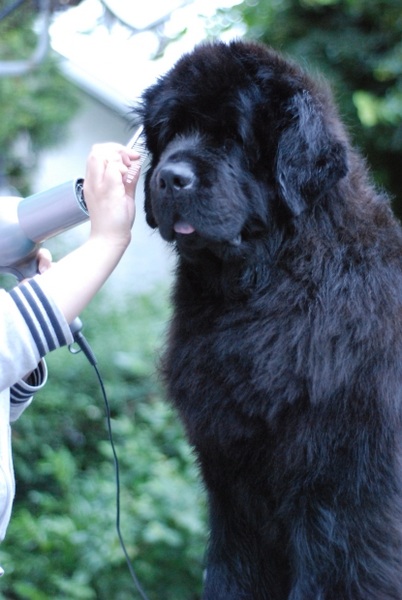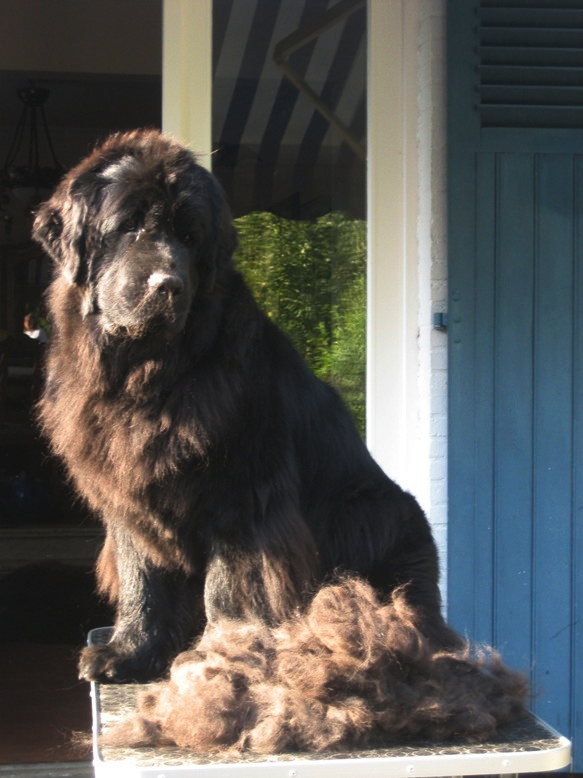Watercubs & Kivisilmän
working show-quality newfoundlands
and history
Original text and pictures by
Anna Grabowska, Italia (kennel
Logrus)
Additional text and
pictures by Salmelin

Trimming a Newfoundland
Equipment:
Shampoo,
conditioner, dry towels
(Pet Towel),
two sponges (one for the shampoo, one for the conditioner),
powerful
dryer, trimming table, nail clippers, metallic comb, soft bruch, scissors,
thinning shears.
- We recommend for a shampoo and conditioner a combination of Jean Peau Volume and Jean Peau Elegance. To give the shine we recommend Jean Peau Mink Oil. Other good products are also Groomer’s Edge Midnight White (shampoo) and Groomer’s Edge Re-Fur-Bish (conditioner).
- For normal trimming (not allowed for shows) mink oil is a good spray to keep the coat cleaner for a longer time after a wash. You can spray it on after for example after a show.
- A very good blow dryer is K9-III.
Hints
to save you
time and to make the end result better:
- If you use bad shampoo or conditioner, the fur becomes horrible: dry, matted and easily tangled.
- Good equipment is important and worth the extra cash. Especially dryer and scissors!
- You can trim a newf without the table, but it's easier for your back, the dog stays still and you can see the results better.
- Before you start trimming, the dog needs to be brushed, washed and dryed. A newfie is a big dog so buy a dog dryer (recommend K-9 III) : hand dryers aren't good enough and blow hot air which is a definite No! Blowdryers designed for humans are not powerful enough to dry the whole fur, but are very good tools for drying the muzzle and the ears. The dog should be trimmed when it is dry, for example a day after you have washed him.
- You get the best result if you trim a show Newfie every other week. A dog who doesn't go to shows should be washed every three months, so that the fur stays healthy.
- If the coat is dry, you should oil it before the wash.
- When you practice trimming, don't do it right before the show day, because a wrongly cut fur needs a few days to grow back. It's better to cut too little than too much for the first times.
- Newfoundlands should have a medium length fur without any overlong hairs. A trimmed newf should look natural, so avoid making "cut lines". The thinning shears are excellent for this purpose.
- After the dog is trimmed, let someone else show him and look yourself if there is anything that needs to be cut.
- You can always print two pictures: one of your own and one of an already trimmed newf. Compare and contrast. You can draw lines on the paper to make sure you cut in the right places. The dog will look different on the table and on the floor, make sure he's pretty both ways.
Washing
the dog:
Wet the dog with lukewarm water. Make sure that the undercoat gets wet as well. Make sure that the water isn't too hot, so that the underwool doesn't mat. When wetting the dog, it's easier if you wet the sponge with a little bit of shampoo, this breaks the water tension and the dog gets wet. Use the sponge to distribute the shampoo, because this distributes it equally all around its body. Remember to shampoo the snout and ears too, but be careful!! Rub the shampoo until it foams. Rinse the shampoo out carefully and make sure you take everything out. Dry shampoo will make the skin itchy. If the coat still feels dirty, wash it again.
Next use the conditioner. Distribute it in the same way as the shampoo. It's not supposed to foam. Let the conditioner rest on the fur for five minutes and then rinse it off. The conditioner returns the oil back onto the fur, so USE A GOOD ONE! It makes all the difference. By distributing the conditioner unequally you can enhance certain parts of the body. If you have a show the next day, make sure you do not leave any conditioner in the fur, however if you do not have a show to go to, you can leave a bit of conditioner in the coat.
Now it's a good time to walk the dog for a short walk, (don't let it go free or else he'll find a mud puddle and we all know what he'll look like afterwards!). During the walk the dog will probably shake all the extra water off, making your job easier. Usually ordinary towels aren't very good for drying a newfie, because they get wet too easily and you need a big bunch of them before you get him towel dry. Use instead for example "PetTowel", which sucks in all the water, it'll suck at least 10 litres (or that's what it feels like!!) It is a good idea to squeeze the water put of the paws before drying.
Many shampoos are not 'powerful' enough for Newfoundlands' double coat, and leave the fur too soft, which is why it is always a good idea to test a shampoo before buying it. The shampoos sold in dog shows are better quality than the ones you find in pet shops. You should always pay for quality as it saves you time and usually money in the long run. If you wash your dog with a bad shampoo or conditioner, your dog will become a furry, soft-haired, tangled mess. We have found Groomer’s Edge Re-Fur-Bish to be a good conditioner and Groomer's Edge Midnight White to be a good shampoo for a brown dog. Jean Peau Volume and Jean Peau Elegance work better with a black dog's coat.
If you're not going to shows a good spray on the fur is mink oil: it repells dirt and keeps the ticks away. It also makes the coat oilier and thus keeps it from matting.
Drying
First remove all excess water away with a towel. Squeezing the paws and using a PetTowel helps. Then blow all the water way from the skin, be careful around the eyes, snout and ears. Always dry along (not against) the coat. Start from the top, dry downwards, from front to back and finally between the legs. If your newfie's got a wavy coat, you may brush at the same time, but be careful not to scratch the skin.
Dry the paws blowing from below. That way he will get bigger paws as the fur stays erect.
When the
dog is completely dry, you can start brushing it. The fur on the ears curl
fast, so you may need to comb them while drying. If the dog’s coat becomes
too wavy after the drying, you may want to wet it again.
Brushing and combing
First brush the whole coat, then comb it carefully. If your dog's got matts, start untangling them from the tip towards the roots. If the matt is very big, you may cut it vertically, never horizontally! Start from the behind: lift the hair up with one hand while you comb with the other. Never comb against the coat. Then the other leg, gently between them, then the tail from top to tip. Brush the back next: from the behind toward the neck, then the sides from the belly toward the topline. Remember to untangle the elbowpits. Last the front: front legs, paws, neck, ears (below and top, remember to check that the "pocket" is open) and head. Cut the nails and clean the ears.
Trimming
The
trimming influences the whole appearance of the dog.
Before:



After:



Paws
Always start from the front paws. First below. Cut all the excess hair that
you can see.


Brush the fur on the paw up with the brush and cut it to look like a tennisball. Don't cut too much, it should be round and look like a cat's paw. It is not necessary to cut so that the nails can be seen. The fur on the back of the front leg (=feathers) must be cut slightly curvy upwards.








Cut the hind legs in a similar fashion.
Now, change
your scissors to thinning shears and use only them and a comb
from now on. Always cut along the fur, never against. Comb, cut,
comb, cut..
Front
First cut the feathers away. If the dog's got a narrow front you can cut
more from between the front legs and vice versa. Our goal is to cut clean
lines, so take all the feather that causes the shaggy look away.


Behind
The
same rules apply. Cut more from between if the dog is narrow, less if it is
too wide.


Find the back angles, cut all the excess feather away from below the knee and back of the leg. Newfies should have short back of back legs, trim all fur from there at an angle of 45° downwards, the bottom at a straight angle, like shown in the pictures.


Chest
The
chest is usually too furry and it usually has too much overlong feathers.
Especially under the chin should be cut carefully. Too long fur under the
chestbone will make the dog appear too low, so cut it so that it becomes a
smooth curve. Trim the excess feathers from the sides of the chest, from
below the ears to the legs.


Underline
Start from the behind, going towards the chest. First left hind leg, then
right hind leg.. Trim the underline all the way to the chest. Join the
underline with a smooth curve to the chest. If you cut too much, the dog
will look too high and vice versa.


Elbowpits
List
the front legs one by one and cut the hair away, joining the chest with the
underline in a smooth curve. Overlong fur will be seen in movement.


Now, imagine the dog from the front: The underline must be smoothly connected to the chest. Not only looking from the side but also looking from in front.



Topline
Usually the topline isn't necessary to trim, but if it is, it's usually the
neck or the behind, which give an impression that the dog has a bad back.
Only use thinning shears.




Tail
The
tail should be like a flag.


Head
Start from
the ears, trim all the hair exceeding the edge all the way to the check.
Remember to comb downwards. The tip of the ear must be round.


Now under the ear. Cut all the "dirty" fur away. Start from the cheek and
continue down towards the ear pocket. Repeat, but now lower, from the eye to
the "tip of the ear".


Usually there are feathers behind the ears. Trim the away, downwards.


Last, the head. First comb all the fur up, then cut all the excess hair away, heading towards a round head.


----------------
(c) Salmelin